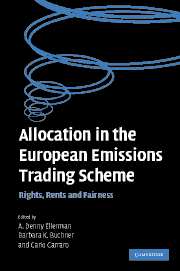Book contents
- Frontmatter
- Contents
- List of figures
- List of boxes
- List of tables
- List of contributors
- Introductory note/Foreword
- Acknowledgements
- Glossary and abbreviations
- Part I The EU ETS allocation process
- Part II Experiences from Member States in allocating allowances
- 3 United Kingdom
- 4 Germany
- 5 Denmark
- 6 Sweden
- 7 lreland
- 8 Spain
- 9 Italy
- 10 Hungary
- 11 Czech Republic
- 12 Poland
- Part III Concluding remarks and background material
- Appendix I Participants
- Appendix II The individual country outlines
- Appendix III The country tables
- Appendix IV Background material from the European Commission
- Index
8 - Spain
Published online by Cambridge University Press: 22 September 2009
- Frontmatter
- Contents
- List of figures
- List of boxes
- List of tables
- List of contributors
- Introductory note/Foreword
- Acknowledgements
- Glossary and abbreviations
- Part I The EU ETS allocation process
- Part II Experiences from Member States in allocating allowances
- 3 United Kingdom
- 4 Germany
- 5 Denmark
- 6 Sweden
- 7 lreland
- 8 Spain
- 9 Italy
- 10 Hungary
- 11 Czech Republic
- 12 Poland
- Part III Concluding remarks and background material
- Appendix I Participants
- Appendix II The individual country outlines
- Appendix III The country tables
- Appendix IV Background material from the European Commission
- Index
Summary
Introductory background and context
Climate policy in Spain
An integrated climate policy has been lacking in Spain, at least until 2004 when the National Climate Change Strategy was approved. Several scattered, sector-specific measures indirectly leading to CO2 emissions have been applied or recently approved, but they were mostly implemented to reach other goals (e.g. to improve employment and regional development opportunities, to reduce foreign energy dependency or to increase the competitiveness of national industry by raising its energy efficiency). The following two are worth mentioning:
RES-E Promotion. The National Plan for the Promotion of Renewable Energy Sources (NPPES) sets a 12% energy consumption target coming from renewables in 2010 (29% of renewable electricity). This Plan aims to reduce emissions by 28 Mt CO2e annually up to 2010 by substituting renewable energy for conventional energy sources with several measures (particularly the granting of feed-in tariffs to renewable generators).
Energy Efficiency and Energy Savings Strategy (2004–2012) aiming at the control of energy-related CO2 emissions by partly subsidising energy-efficient technological change in industrial firms. With the Strategy, CO2 emissions would increase by 58% in 2012 compared to 1990 (instead of a 78% increase). This represents an accumulated reduction of 190 Mt CO2 in 2004–2012.
These policies mainly focus on the industry and energy sectors. Measures tackling emissions from other sectors are even more limited. In general, fiscal deductions and exemptions, tax relief, direct subsidies and, to a lesser extent, voluntary agreements are applied in all sectors.
- Type
- Chapter
- Information
- Allocation in the European Emissions Trading SchemeRights, Rents and Fairness, pp. 182 - 212Publisher: Cambridge University PressPrint publication year: 2007

